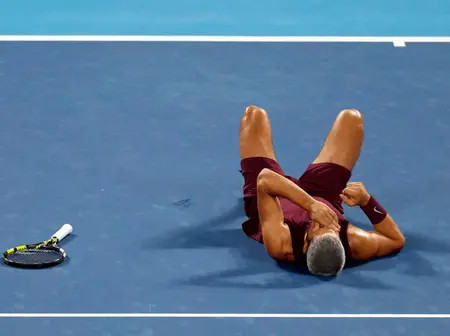World No. 1 Carlos Alcaraz began his Japan Open tournament with a hard-fought 6−4, 6−2 victory over Sebastian Baez, but it was far from easy.
Early in the match, Alcaraz twisted his left ankle and fell to the court, admitting he was “scared” and needed a lengthy medical timeout for strapping.
A quick rain delay followed, giving him a crucial break to recover his focus.
He used his mental strength and a powerful serve to win the first set and then dominated the second, showing the resilience needed to win major events.
Off the court, Alcaraz is also a key figure in the player movement asking the Grand Slams to give athletes a larger share of the tournament money and better long-term benefits like pensions and healthcare.
The dramatic moment arrived in the fifth game of the opening set.
Chasing a wide shot, Alcaraz twisted his left ankle and dropped to the court in visible pain, immediately calling for the medical team.
The 22-year-old required a lengthy medical timeout where trainers tightly strapped his ankle before he could continue.
The tension was palpable in the Ariake Coliseum as the top seed considered retiring.
“I was scared. I’m not gonna lie,” Alcaraz admitted after the match, revealing his initial fears.
Adding to the chaos, light rain forced a 30-minute delay, allowing the organizers to close the stadium roof.
For Alcaraz, this break served as a crucial reset.
In professional tennis, even a minor Grade 1 ankle sprain can sideline a player for days to weeks.
By choosing to continue, heavily taped, Alcaraz demonstrated his championship grit.
He immediately broke Baez to take a 5-4 lead before closing out the first set, turning potential disaster into a decisive advantage.
With the ankle stabilized and the roof closed, Alcaraz finally found his signature explosive game.
The second set was a clear statement of intent, as the Spaniard surged to a quick lead and secured a convincing 6-2 finish, taking the match in just over an hour and a half.
Alcaraz’s serve was a major weapon; he landed an impressive 77% of his first serves and won 72% of those points—a clear statistical edge over his opponent.
This performance continues his exceptional form, fresh off winning the US Open earlier this month.
The Japan Open, an ATP 500 event, is a critical stop as Alcaraz builds momentum for the final major events of what he has called his best season yet.
His next challenge will be on September 27 against the winner of the first-round clash between Zizou Bergs and Alejandro Tabilo.
While Alcaraz battles opponents on the court, he is also playing a key role in an important fight off it.
The top-ranked player is one of the leading voices in a collective push by ATP and WTA stars to demand a fairer slice of the revenue generated by the four Grand Slam tournaments.
The players, who generate the spectacle and draw the fans, are asking the Grand Slams—the sport’s most profitable events—to increase the players’ share of tournament revenue from the current 16% to 22% by 2030.
They are also advocating for the creation of welfare programs, including annual contributions for pensions and healthcare, which would amount to over $12 million a year.
Alcaraz’s commitment to competing at the highest level, despite physical risks like his ankle scare, reinforces the value and risk the players bring to the sport, strengthening their case for greater compensation and a bigger say in the future of tennis.

Leave a Reply